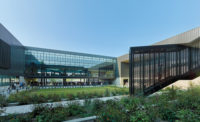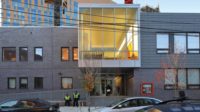Fayetteville, Arkansas
At the beginning of the 20th century, Maria Montessori wrote, “Education is a natural process carried out by the human individual, and is acquired not by listening to words, but by experiences in the environment.” The line paints in broad strokes the educational philosophy that bears her name, with its emphasis on independent, creative, and hands-on learning over classical rigid instruction. But when Victoria Butler, owner of a thriving Montessori school in Northwest Arkansas, decided to add an elementary school to her primarily early-childhood program, she found that the city of Fayetteville had a more traditional, textbook-like approach to rules and regulations.
Butler’s school occupies a cluster of five residential-scale buildings, hemmed in on one side by an aggressively bland shopping center but bounded on the other by a grassy field and a creek. She chose a lot in the middle of her existing buildings for the elementary school but discovered that in the decade or so since she acquired the property, a city ordinance had extended the boundary of the creek’s floodplain to include nearly two thirds of the site, leaving only a triangular sliver of buildable area. The building code also required that, to avoid runoff’s flowing directly into the stream, the small area had to retain and filter into the soil not only its own stormwater but also any that drained into the site from the neighboring parking lots. “It was a hell of a difficult site,” says Marlon Blackwell, whom Butler hired to design the project, and whose two children attended her school. “We really only had a small triangle to build on.”
Blackwell and his firm responded to the site constraints by playing with blocks. They designed a 7,940-square-foot, steel-frame building with two simple geometric volumes. Following the line of the floodplain, the ground floor has a triangular plan with a cut into its south side that turns it into a V shape. The upper floor is a rectangular box stacked on one wing of the V. It juts out over the floodplain in the rear of the building to create a shaded play area below. A single column, the maximum allowed in the floodway, supports the protruding section of the structure. “We tried a doughnut, we tried a big box raised above the ground, we tried all kinds of forms,” says project director Meryati Johari Blackwell, a principal at the firm and Marlon’s wife. “But basically these shapes are the ones that best served the client’s needs.”
To manage the stormwater, the firm planted a green roof on the single-story wing of the V and lined the south, street-facing side of the building with a rain garden that extends into the courtyard made by the cut-away section of the ground floor. Teachers frequently incorporate the verdant area into nature-focused classroom activities.
Set among the greenery, the building strikes a compromise between the inviting and the economical with its facades. The firm clad the two primary street-facing elevations in a clear-sealed cypress, and recessed the entry on one side and a row of windows on the other. “South-facing porches are a big part of our southern vernacular,” explains project manager Bradford Payne. The rest of the building is sheathed in a dark bronze-colored corrugated metal, the type typically used for garages, sheds, or big-box stores.
The contrast between the warmth of the light wood and the chill of the dark metal allows the building to read as both welcoming and sophisticated, a move designed to appeal to the parents of older students. “The culture used to be that students remained here until kindergarten,” says Butler. “I wanted to expand the elementary school, but I couldn’t do that in a building that looked like a day-care center. It had to look like something parents could relate to as a school.
By stacking a box on top of a triangular volume, the firm fit four rectangular classrooms onto the building’s footprint, which was essential, says Payne, for allowing standard Montessori furniture to be reconfigured easily for different activities. The interior finishes take a cue from the simplicity of the child-size bookshelves and other spare, wooden furnishings. White walls, light wood, and glass create a bright, neutral atmosphere interrupted only by the school’s collection of corals, fossils, and other objects meant to spark students’ curiosity (a buffalo skin hangs over the stairwell). The materials provide a platform for student art projects as well—on a recent visit, a class had made miniature versions of artist Roxy Paine’s signature metal tree sculptures, one of which stands outside the Crystal Bridges Museum of American Art in nearby Bentonville.
Even for an adult, the school has an inspiring but calm air brought about by the building’s creative response to the strictures of its location. “When we start a project, our design process begins with exploring what the site gives us,” says Payne. Montessori would have approved of that discovery-focused approach.
People
Owner:
Architect:
Personnel in architect's firm who should receive special credit: MBA Project Team: Meryati Johari Blackwell Assoc. AIA, NCDIQ, ASID, LEED AP BD+D, project director; Bradford Payne, project manager; Jonathan Boelkins AIA, William Burks Assoc. AIA, Stephen Reyenga Assoc. AIA, Michael Pope Assoc. AIA, Justin Hershberger, Assoc. AIA
Architect of Record and Design Architect:
General contractor:
Structural Engineer:
Mechanical, Electrical, Plumbing, Fire Protection Engineer:
Civil Engineer:
Landscape Architect:
Lighting Designer:
Geotechnical Consultant:
LEED Project Team:
General contractor:
Photographer:
Renderer:
CAD system, project management, or other software used: Size: 7,940 square feet Cost: $1.4 million Completion date: August 2012 |
Products
Structural system
Exterior cladding
Curtain Wall:
Architectural Metals and custom stair:
Tongue and Groove Wood Siding: Cypress, Subcontractor:
Moisture barrier:
Roofing
Green Roof:
Windows
Curtain wall systems:
Glazing
Doors
Entrance Mats:
Wood doors:
Aluminum door frames:
Hardware
Closers:
Exit devices:
Pulls:
Security devices:
Interior finishes
Paints and stains:
Acoustic Ceiling:
All Millwork:
Plastic laminate:
Quartz and solid surfacing:
Floor:
Ceramic Tile:
Furnishings
Commercial Kitchen:
Lighting
Exterior:
Conveyance
Plumbing
Energy Other unique products that contribute to sustainability: 1. Greenroof: Firestone Interlocking Green Roof Trays. |










